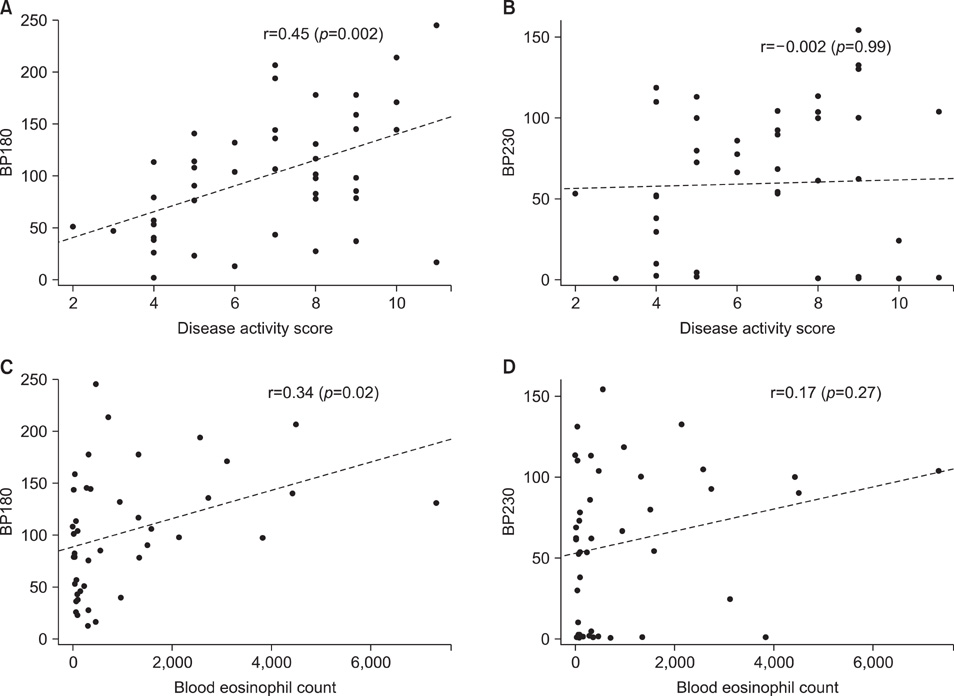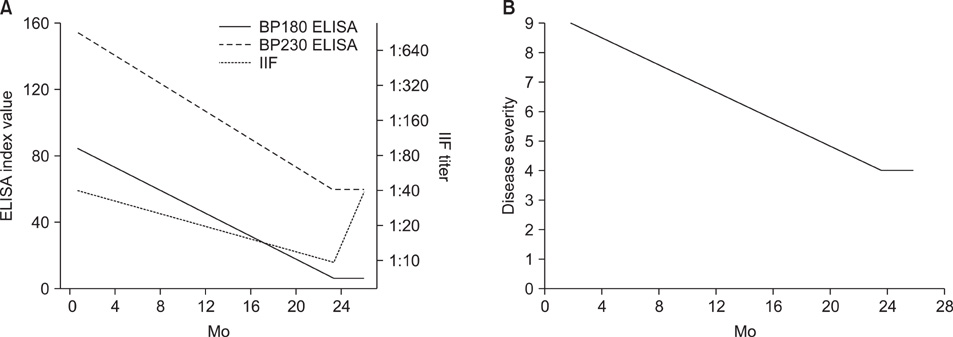Ann Dermatol.
2012 Feb;24(1):45-55. 10.5021/ad.2012.24.1.45.
Usefulness of Enzyme-linked Immunosorbent Assay Using Recombinant BP180 and BP230 for Serodiagnosis and Monitoring Disease Activity of Bullous Pemphigoid
- Affiliations
-
- 1Department of Dermatology, Yonsei University College of Medicine, Seoul, Korea. kimsc@yuhs.ac
- 2INC Research, Wilmington, NC 28403, USA.
- 3Department of Laboratory Medicine, Yonsei University College of Medicine, Seoul, Korea.
- KMID: 2156855
- DOI: http://doi.org/10.5021/ad.2012.24.1.45
Abstract
- BACKGROUND
Bullous pemphigoid (BP) is an autoimmune subepidermal bullous disease associated with autoantibodies against BP180 and BP230. Enzyme-linked immunosorbent assay (ELISA) is a sensitive tool for the detection of immunoglobulin G (IgG) anti-BP180 and anti-BP230 autoantibodies.
OBJECTIVE
The aim of this study was to evaluate the usefulness of ELISA for diagnosing and monitoring the disease activity of BP.
METHODS
We evaluated serum IgG levels of anti-BP180 and anti-BP230 autoantibodies in 47 BP patients, 16 epidermolysis bullosa aquisita patients, and 15 healthy volunteers using ELISA. Through retrospective review of the medical records, the clinical characteristics of BP including disease activity, duration, pruritus severity and peripheral blood eosinophil counts were assessed.
RESULTS
The sensitivity of BP180 ELISA was 97.9%, BP230 ELISA 72.3%, and a combination of the two was 100%. The specificity of BP180 ELISA was 90.3%, BP230 ELISA 100%, and a combination of the two was 90.3%. BP180 ELISA scores showed strong associations with disease activity, pruritus severity, peripheral blood eosinophil counts, and disease duration, whereas BP230 ELISA scores did not.
CONCLUSION
BP180 and BP230 ELISAs are highly sensitive methods for the diagnosis of BP, and BP180 ELISA, in particular, is a sensitive tool for monitoring the disease activity of BP.
MeSH Terms
Figure
Cited by 1 articles
-
Circulating Eosinophil and Neutrophil Counts Correlate with Disease Severity in Bullous Pemphigoid
Seh Hyun Park, Si-Hyung Lee, Jong Hoon Kim, Soo-Chan Kim
Ann Dermatol. 2018;30(5):544-549. doi: 10.5021/ad.2018.30.5.544.
Reference
-
1. Lever WF. Pemphigus. Medicine (Baltimore). 1953. 32:1–123.
Article2. Liu Z, Diaz LA. Bullous pemphigoid: end of the century overview. J Dermatol. 2001. 28:647–650.
Article3. Diaz LA, Ratrie H 3rd, Saunders WS, Futamura S, Squiquera HL, Anhalt GJ, et al. Isolation of a human epidermal cDNA corresponding to the 180-kD autoantigen recognized by bullous pemphigoid and herpes gestationis sera. Immunolocalization of this protein to the hemidesmosome. J Clin Invest. 1990. 86:1088–1094.
Article4. Stanley JR, Tanaka T, Mueller S, Klaus-Kovtun V, Roop D. Isolation of complementary DNA for bullous pemphigoid antigen by use of patients' autoantibodies. J Clin Invest. 1988. 82:1864–1870.
Article5. Giudice GJ, Emery DJ, Diaz LA. Cloning and primary structural analysis of the bullous pemphigoid autoantigen BP180. J Invest Dermatol. 1992. 99:243–250.
Article6. Hirako Y, Usukura J, Nishizawa Y, Owaribe K. Demonstration of the molecular shape of BP180, a 180-kDa bullous pemphigoid antigen and its potential for trimer formation. J Biol Chem. 1996. 271:13739–13745.
Article7. Schäcke H, Schumann H, Hammami-Hauasli N, Raghunath M, Bruckner-Tuderman L. Two forms of collagen XVII in keratinocytes. A full-length transmembrane protein and a soluble ectodomain. J Biol Chem. 1998. 273:25937–25943.8. Hopkinson SB, Baker SE, Jones JC. Molecular genetic studies of a human epidermal autoantigen (the 180-kD bullous pemphigoid antigen/BP180): identification of functionally important sequences within the BP180 molecule and evidence for an interaction between BP180 and alpha 6 integrin. J Cell Biol. 1995. 130:117–125.
Article9. Borradori L, Koch PJ, Niessen CM, Erkeland S, van Leusden MR, Sonnenberg A. The localization of bullous pemphigoid antigen 180 (BP180) in hemidesmosomes is mediated by its cytoplasmic domain and seems to be regulated by the beta4 integrin subunit. J Cell Biol. 1997. 136:1333–1347.
Article10. Zillikens D, Rose PA, Balding SD, Liu Z, Olague-Marchan M, Diaz LA, et al. Tight clustering of extracellular BP180 epitopes recognized by bullous pemphigoid autoantibodies. J Invest Dermatol. 1997. 109:573–579.
Article11. Giudice GJ, Emery DJ, Zelickson BD, Anhalt GJ, Liu Z, Diaz LA. Bullous pemphigoid and herpes gestationis autoantibodies recognize a common non-collagenous site on the BP180 ectodomain. J Immunol. 1993. 151:5742–5750.
Article12. Murakami H, Nishioka S, Setterfield J, Bhogal BS, Black MM, Zillikens D, et al. Analysis of antigens targeted by circulating IgG and IgA autoantibodies in 50 patients with cicatricial pemphigoid. J Dermatol Sci. 1998. 17:39–44.
Article13. Balding SD, Prost C, Diaz LA, Bernard P, Bedane C, Aberdam D, et al. Cicatricial pemphigoid autoantibodies react with multiple sites on the BP180 extracellular domain. J Invest Dermatol. 1996. 106:141–146.
Article14. Sitaru C, Powell J, Messer G, Bröcker EB, Wojnarowska F, Zillikens D. Immunoblotting and enzyme-linked immunosorbent assay for the diagnosis of pemphigoid gestationis. Obstet Gynecol. 2004. 103:757–763.
Article15. Ruhrberg C, Watt FM. The plakin family: versatile organizers of cytoskeletal architecture. Curr Opin Genet Dev. 1997. 7:392–397.
Article16. Green KJ, Virata ML, Elgart GW, Stanley JR, Parry DA. Comparative structural analysis of desmoplakin, bullous pemphigoid antigen and plectin: members of a new gene family involved in organization of intermediate filaments. Int J Biol Macromol. 1992. 14:145–153.
Article17. Yang Y, Dowling J, Yu QC, Kouklis P, Cleveland DW, Fuchs E. An essential cytoskeletal linker protein connecting actin microfilaments to intermediate filaments. Cell. 1996. 86:655–665.
Article18. Hopkinson SB, Jones JC. The N terminus of the transmembrane protein BP180 interacts with the N-terminal domain of BP230, thereby mediating keratin cytoskeleton anchorage to the cell surface at the site of the hemidesmosome. Mol Biol Cell. 2000. 11:277–286.
Article19. Sonnenberg A, Nievers M, Schaapveld R, Geerts D, Niessen C, Borradori L. Interaction of BP180 and alpha6beta4. J Invest Dermatol. 1999. 112:830–832.20. Anhalt GJ, Kim SC, Stanley JR, Korman NJ, Jabs DA, Kory M, et al. Paraneoplastic pemphigus. An autoimmune mucocutaneous disease associated with neoplasia. N Engl J Med. 1990. 323:1729–1735.
Article21. Hamada T, Nagata Y, Tomita M, Salmhofer W, Hashimoto T. Bullous pemphigoid sera react specifically with various domains of BP230, most frequently with C-terminal domain, by immunoblot analyses using bacterial recombinant proteins covering the entire molecule. Exp Dermatol. 2001. 10:256–263.
Article22. Kelly SE, Bhogal BS, Wojnarowska F, Whitehead P, Leigh IM, Black MM. Western blot analysis of the antigen in pemphigoid gestationis. Br J Dermatol. 1990. 122:445–449.
Article23. Zillikens D, Mascaro JM, Rose PA, Liu Z, Ewing SM, Caux F, et al. A highly sensitive enzyme-linked immunosorbent assay for the detection of circulating anti-BP180 autoantibodies in patients with bullous pemphigoid. J Invest Dermatol. 1997. 109:679–683.
Article24. Kobayashi M, Amagai M, Kuroda-Kinoshita K, Hashimoto T, Shirakata Y, Hashimoto K, et al. BP180 ELISA using bacterial recombinant NC16a protein as a diagnostic and monitoring tool for bullous pemphigoid. J Dermatol Sci. 2002. 30:224–232.
Article25. Hofmann S, Thoma-Uszynski S, Hunziker T, Bernard P, Koebnick C, Stauber A, et al. Severity and phenotype of bullous pemphigoid relate to autoantibody profile against the NH2- and COOH-terminal regions of the BP180 ectodomain. J Invest Dermatol. 2002. 119:1065–1073.
Article26. Nakatani C, Muramatsu T, Shirai T. Immunoreactivity of bullous pemphigoid (BP) autoantibodies against the NC16A and C-terminal domains of the 180 kDa BP antigen (BP180): immunoblot analysis and enzyme-linked immunosorbent assay using BP180 recombinant proteins. Br J Dermatol. 1998. 139:365–370.
Article27. Mariotti F, Grosso F, Terracina M, Ruffelli M, Cordiali-Fei P, Sera F, et al. Development of a novel ELISA system for detection of anti-BP180 IgG and characterization of autoantibody profile in bullous pemphigoid patients. Br J Dermatol. 2004. 151:1004–1010.
Article28. Tampoia M, Lattanzi V, Zucano A, Villalta D, Filotico R, Fontana A, et al. Evaluation of a new ELISA assay for detection of BP230 autoantibodies in bullous pemphigoid. Ann N Y Acad Sci. 2009. 1173:15–20.
Article29. Schmidt E, Obe K, Bröcker EB, Zillikens D. Serum levels of autoantibodies to BP180 correlate with disease activity in patients with bullous pemphigoid. Arch Dermatol. 2000. 136:174–178.
Article30. Haase C, Büdinger L, Borradori L, Yee C, Merk HF, Yancey K, et al. Detection of IgG autoantibodies in the sera of patients with bullous and gestational pemphigoid: ELISA studies utilizing a baculovirus-encoded form of bullous pemphigoid antigen 2. J Invest Dermatol. 1998. 110:282–286.
Article31. Amo Y, Ohkawa T, Tatsuta M, Hamada Y, Fujimura T, Katsuoka K, et al. Clinical significance of enzyme-linked immunosorbent assay for the detection of circulating anti-BP180 autoantibodies in patients with bullous pemphigoid. J Dermatol Sci. 2001. 26:14–18.
Article32. Di Zenzo G, Thoma-Uszynski S, Fontao L, Calabresi V, Hofmann SC, Hellmark T, et al. Multicenter prospective study of the humoral autoimmune response in bullous pemphigoid. Clin Immunol. 2008. 128:415–426.
Article33. Yoshida M, Hamada T, Amagai M, Hashimoto K, Uehara R, Yamaguchi K, et al. Enzyme-linked immunosorbent assay using bacterial recombinant proteins of human BP230 as a diagnostic tool for bullous pemphigoid. J Dermatol Sci. 2006. 41:21–30.
Article34. Kromminga A, Sitaru C, Hagel C, Herzog S, Zillikens D. Development of an ELISA for the detection of autoantibodies to BP230. Clin Immunol. 2004. 111:146–152.
Article35. Thoma-Uszynski S, Uter W, Schwietzke S, Hofmann SC, Hunziker T, Bernard P, et al. BP230- and BP180-specific auto-antibodies in bullous pemphigoid. J Invest Dermatol. 2004. 122:1413–1422.
Article36. Herbst A, Bystryn JC. Patterns of remission in pemphigus vulgaris. J Am Acad Dermatol. 2000. 42:422–427.
Article37. Liu Z, Diaz LA, Troy JL, Taylor AF, Emery DJ, Fairley JA, et al. A passive transfer model of the organ-specific autoimmune disease, bullous pemphigoid, using antibodies generated against the hemidesmosomal antigen, BP180. J Clin Invest. 1993. 92:2480–2488.
Article38. Jordon RE, Heine KG, Tappeiner G, Bushkell LL, Provost TT. The immunopathology of herpes gestationis. Immunofluorescence studies and characterization of "HG factor". J Clin Invest. 1976. 57:1426–1431.
Article39. Korman NJ. In situ-bound antibodies eluted from the skin of patients with bullous pemphigoid are preferentially directed against the 230-kD bullous pemphigoid antigen. J Invest Dermatol. 1995. 105:824–830.
Article40. Hall RP 3rd, Murray JC, McCord MM, Rico MJ, Streilein RD. Rabbits immunized with a peptide encoded for by the 230-kD bullous pemphigoid antigen cDNA develop an enhanced inflammatory response to UVB irradiation: a potential animal model for bullous pemphigoid. J Invest Dermatol. 1993. 101:9–14.
Article41. Kiss M, Husz S, Jánossy T, Marczinovits I, Molnár J, Korom I, et al. Experimental bullous pemphigoid generated in mice with an antigenic epitope of the human hemidesmosomal protein BP230. J Autoimmun. 2005. 24:1–10.
Article42. Tsuji-Abe Y, Akiyama M, Yamanaka Y, Kikuchi T, Sato-Matsumura KC, Shimizu H. Correlation of clinical severity and ELISA indices for the NC16A domain of BP180 measured using BP180 ELISA kit in bullous pemphigoid. J Dermatol Sci. 2005. 37:145–149.
Article43. Feng S, Wu Q, Jin P, Lin L, Zhou W, Sang H, et al. Serum levels of autoantibodies to BP180 correlate with disease activity in patients with bullous pemphigoid. Int J Dermatol. 2008. 47:225–228.
Article44. Ishiura N, Fujimoto M, Watanabe R, Nakashima H, Kuwano Y, Yazawa N, et al. Serum levels of IgE anti-BP180 and anti-BP230 autoantibodies in patients with bullous pemphigoid. J Dermatol Sci. 2008. 49:153–161.
Article
- Full Text Links
- Actions
-
Cited
- CITED
-
- Close
- Share
- Similar articles
-
- Immunoblot Analysis Using Epidermal Extract and 180kD Bullous Pemphigoid Antigen NC16a Domain in the Diagnosis of Subepidermal Bullous Diseases
- A Case of Chronic Bullous Disease of Childhood That Was Reactive to the Antigen of 120 kDa (LAD-1)
- Correlation between the Peripheral Eosinophil Count and Disease Severity in Patients with Bullous Pemphigoid: A Retrospective 20-Year Single-Center Study
- A Case of Cicatricial Pemphigoid with Autoantibodies Against the BP180 and BP230 Antigens
- Localized Bullous Pemphigoid on Both Upper Extremities in a Hemiplegic Patient







